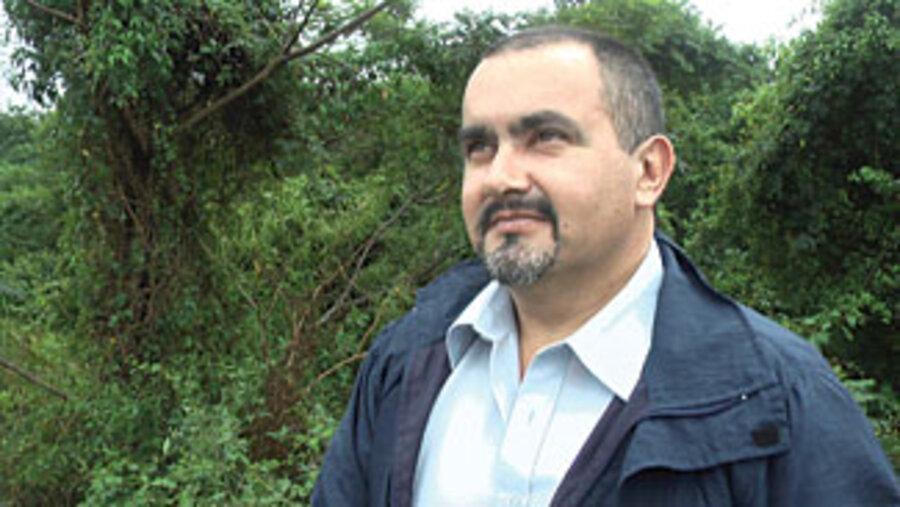People making a difference: Alberto Yanosky
Loading...
| Asunción, Paraguay
Alberto Yanosky zooms up to the curb in his white Kia minivan and, panting, rushes through the doors of the conservation group he leads, Guyra Paraguay.
This morning he has just returned from Uruguay and is headed straight to a talk on climate change at a Japanese-Paraguayan center in Asunción, Paraguay's capital city. He has several meetings to cram in over the next few days before leaving again – this time for the Atlantic forest in eastern Paraguay.
In short, this is a man who rarely stops in his crusade to protect Paraguay from an onslaught of soybean farmers, biofuel entrepreneurs, and private landowners who are slicing, dicing, and selling its lands away – including national parkland that one politician was apparently handing out to friends.
"He is always asking, 'What else can we do? What can we do?' " says José Luis Cartes, a Guyra Paraguay staff member. That probing has led Mr. Yanosky into collaborations with NASA space scientists in the United States, local indigenous communities who still hunt with bow and arrow, and farming interests who have sown grain across the eastern frontier. At Paraguay's Environmental Ministry he is seen so often he's mistaken for a member of the staff.
Now Yanosky is embarking on perhaps one of the greatest challenges of his career: His nongovernmental organization (NGO) is taking on comanagement of three national parks in Paraguay. With support from the British World Land Trust, it is helping the cash-strapped Paraguayan environmental agency preserve parks in the wild and remote Chaco region in the north, which is rapidly being deforested. If Guyra Paraguay is successful, the effort could become a model for other nations struggling to preserve forests.
"It is a huge challenge," concedes Yanosky, who is busy raising money for the 10-year project. "But with better national parks, we can fight against deforestation."
Paraguay's Chaco region was once nearly forgotten. But with land prices rising in neighboring Brazil, farmers there are finding that $150 a hectare (2.5 acres), a price that has tripled from a few years ago, means they can buy land 10 times cheaper in Paraguay. The result: Since January, about 1,000 hectares (2,500 acres) of Chaco land is deforested daily.
The shared-management idea was spawned during a casual drive to one of Guyra Paraguay's reserves in the Atlantic forest region. The environmental minister at the time, Yanosky says, asked for help to protect the vast national park called Defensores del Chaco.
It had long been a problem: A few years back, a local politician was said to be handing out slices of the land as gifts. The government employed just one ranger to monitor 3,000 square miles. What's more, the ranger's pickup truck was broken, and there was no money for repairs. The minister "wanted us to take it over, but I said no," Yanosky says.
Instead, they agreed to team up.
Guyra Paraguay has added five rangers to Defensores del Chaco and is trying to woo PhD candidates to the park's research station and build scientific interest in Chaco's ecosystem.
The challenges to Paraguay's parks are endless: Some do not even have proper boundaries. Yanosky is trying to create a fund in perpetuity for the parks and is experimenting with a carbon-credit program to halt deforestation that's happening just outside park boundaries.
Shared public-private management has been tried elsewhere, from Costa Rica to Bolivia, but it is still considered experimental.
"The vast majority of places recognized as protected areas are the responsibility of governments," says Jim Rieger, the director of conservation strategies of the Meso American and Caribbean region for The Nature Conservancy, and the former director of the Conservancy's Parks in Peril program. "Governments are not inclined to turn over parts of management to [NGOs], or don't have the opportunity, or it never crossed their minds."
But increasingly comanagement is being seen as an option. "In most Southern Hemisphere countries, governments don't have the resources to manage protected areas as effectively as they would like to," says John Burton, CEO of the World Land Trust.
Such arrangements can stir a nationalistic backlash, especially among those who look suspiciously at NGOs and their foreign funding. If anyone is poised to succeed, though, it is Yanosky, a man who has dedicated his career to the conservation of land in Paraguay, even though he is an Argentine. "I could do this in Singapore, France, or the US," he says about his work. "We only have one environment."
At age 23, with a biology degree in hand, Yanosky and his wife, also a scientist, moved to the Chaco region of Argentina (the region extends across parts of Brazil, Paraguay, and Argentina). For nearly a decade, they had to ride horses 30 miles to reach their home, a house without electricity where both of their daughters were born.
When it came time for the children to go to school, the couple decided to accept an offer in Paraguay. He became a founding member of Guyra Paraguay in 1997 and now serves as executive director. The group also works with soybean and rice producers to introduce more sustainable farming practices. And it owns and runs its own land reserves, where it first experimented with the shared management concept.
If the comanagement program in Paraguay's national parks works, Yanosky would like to see other conservation groups enter into agreements with national parks.
"We never get bored," he says. "I have been in this business for 23 years, and I feel it is just the beginning. There are so many things to do; so many opportunities."





